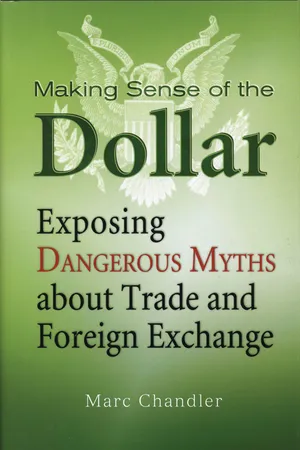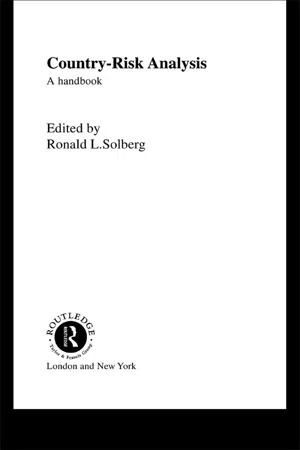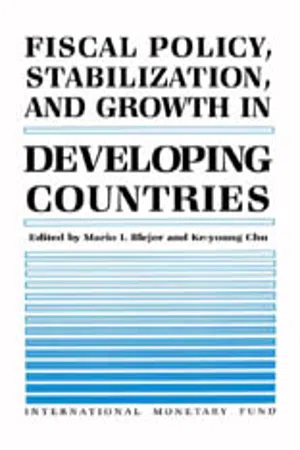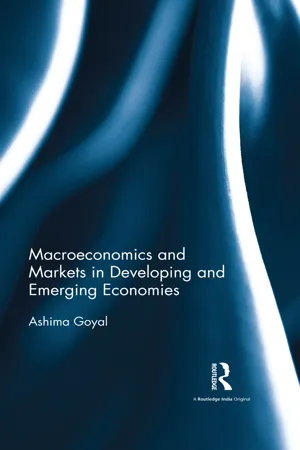Current Account Deficit
A current account deficit occurs when a country's imports exceed its exports, leading to a negative balance of trade. It reflects a net outflow of domestic currency to foreign markets and can indicate a reliance on foreign financing. A sustained deficit may impact a country's currency value and overall economic stability.
8 Key excerpts on "Current Account Deficit"
- eBook - ePub
- Eamonn Butler(Author)
- 2021(Publication Date)
- London Publishing Partnership(Publisher)
...So now, the dollars that Britain’s exports brought in would buy more at home, while imports (now costlier in sterling) fell, all helping to reduce the deficit. Savings and investment can also affect a country’s deficit. People’s savings provide the funds that businesses need in order to invest in their production. If savings fall below what firms are investing, firms need to source more capital from abroad. And if people spend rather than save, that raises demand and sucks in imports. The result is a higher current/financial account deficit. A shortage of domestic savings to fund companies’ investment is one reason why the US runs the world’s largest persistent deficit. (Though exceptionally, it can fund that overspending merely by printing dollars, which keep their value because they are in constant demand as the main currency of international trade.) By contrast, Germany runs the world’s largest trade surplus, partly because the creation of the euro favoured its exporters, but also because of high domestic savings. Japan too has a glut of savings over investment, so savers and fund managers have to look abroad for more profitable investment, giving Japan a current account surplus but a capital account deficit. Country-to-country deficits Because a country’s balance of payments with the world is the result of so many different factors and may be perfectly benign, the mere existence of a deficit is a bad excuse for protectionism. A country’s deficit with any single other country is an even worse excuse – though politicians use it often. US President Donald Trump, for example, cited his country’s trade deficits with China and Mexico as reasons to renegotiate trade deals and raise import barriers. But it should be no surprise that one country runs deficits with another, since it may run surpluses with yet others. The US, for example, imports clothes, electronics and cars from some countries but exports food, oil, financial services and aircraft to others...
- eBook - ePub
Contemporary Economics
An Applications Approach
- Robert Carbaugh(Author)
- 2016(Publication Date)
- Routledge(Publisher)
...The capital and financial account balance is a deficit if those in the United States buy more assets from foreigners than they sell to foreigners. What Does a Current Account Deficit (Surplus) Mean? The current account and the capital and financial account are not unrelated; they are essentially reflections of one another. Recall that each international transaction represents an exchange of goods, services, or assets among households, businesses, or governments. Thus, the two sides of the exchange must always balance. This means that, sign ignored, the current account balance equals the capital and financial account balance, as shown in the following equation: Current account balance=Capital and financial account balance It follows that any Current Account Deficit must be balanced by a capital and financial account surplus. Conversely, any current account surplus must be balanced by a capital and financial account deficit. To better understand this notion, assume that in a particular year your spending is greater than your income. How will you finance your deficit? By borrowing or by selling some of your assets. You might liquidate some real assets (for example, sell your personal computer) or perhaps some financial assets (sell a U.S. government security that you own). In like manner, when a nation experiences a Current Account Deficit, its expenditures for foreign goods and services are greater than the income that it receives from the international sales of its own goods and services, after making allowances for investment income flows and gifts to and from foreigners. The nation must somehow finance its Current Account Deficit. But how? By borrowing or by selling assets. In other words, a nation’s Current Account Deficit is financed essentially by a net inflow of capital in its capital and financial account...
- eBook - ePub
Making Sense of the Dollar
Exposing Dangerous Myths about Trade and Foreign Exchange
- Marc Chandler(Author)
- 2010(Publication Date)
- Bloomberg Press(Publisher)
...The result is a number, not a score for the economy. By definition, the deficit will widen if imports increase by more than exports. Likewise, it will narrow if imports decrease more than exports decrease. The U.S. Current Account Deficit was a hefty $174 billion in the third quarter of 2008. 6 But it’s not the amount that matters so much as why it changes from quarter to quarter. That’s often not a simple matter to determine. Exchange rates matter, of course, but if politicians are obsessed with the trade deficit, then they may pursue policies that generate negative outcomes elsewhere and not necessarily resolve the trade deficit. That can wreak havoc with other sectors of the domestic economy and with key sectors in international trade, especially international direct investment and financial services. If the dollar is weak, then U.S. goods might cost less for people using other currencies, depending on a host of decisions made on the business level such as hedge strategy, competition, and elasticity of demand. A weak dollar might help U.S. exports. But the best thing for U.S. exports is strong foreign demand. U.S. exports were indeed strong in the middle of this decade when the dollar was weak, but U.S. exports were also strong in the second half of the 1990s when the dollar was strong. Foreign demand for U.S. goods is more sensitive to a country’s growth than the level of the dollar. And, if the dollar is weak, imported goods may become more expensive for people paying with dollars, so Americans might buy fewer imports. However, the reduction of demand for imports tends to correspond to what economists call “demand destruction” or, more broadly, economic weakness. Often it is difficult to separate the impact of weaker growth (e.g., lower interest rates) from a weaker dollar for narrowing of the U.S. Current Account Deficit during recessions. The U.S. Current Account Deficit improved sharply in the 2006- 2008 period, but most Americans were worse off...
- eBook - ePub
- Javier A. Reyes, W. Charles Sawyer(Authors)
- 2019(Publication Date)
- Routledge(Publisher)
...10 Financing current-account deficits Introduction In the previous chapter, an important concept was introduced. This involves the relationship between the current account and the financial account. Over a period of time, such as a year, these two accounts should be equal in magnitude and opposite in sign. Another way of putting this is that the total amount of inflows into a country should match the total amount of outflows. If a country has a current-account deficit, it should have a financial-account surplus. The reverse is also true: A current-account surplus should be matched by a financial-account deficit. In the modern history of Latin America, the former has been much more common than the latter. Until recently, ISI combined with overvalued exchange rates tended to create a high demand for imports coupled with difficulties in exporting goods other than commodities. This has obvious implications for the financial account. The current-account deficits in the region created a relentless need for inflows into the financial account. The purpose of this chapter is to illustrate how countries at Latin America’s level of economic development usually accomplish this. As we will see, a financial-account surplus can be accomplished in a number of ways. In the previous chapter, we showed how a country could deal with current-account deficits by either using previously accumulated reserves or, less prudently, relying on a complex system of exchange controls. There are other mechanisms available. Middle-income countries can frequently manage financial-account surpluses with flows of capital from capital-abundant countries. These flows can take a variety of forms. In the first several sections of the chapter, we will cover these flows in the context of Latin America. In turn, these are FDI, portfolio capital, official development assistance (ODA), remittances, and government borrowing from foreign financial institutions...
- eBook - ePub
Country Risk Analysis
A Handbook
- Ronald L. Solberg(Author)
- 2002(Publication Date)
- Routledge(Publisher)
...How this equality comes about in practice will depend on the nature of the economic regime in force. In a fixed-exchange-rate regime the part of a current-account deficit not financed by other capital inflows will be covered by a change in the official settlements balance; that is, by a reduction in official foreign reserves or by official short-term overseas borrowing. In a flexible exchange-rate regime, the exchange rate itself will be among the economic variables that adjust to equate the flows on the current and capital accounts. This chapter concentrates on the analysis and forecasting of the current account, a fundamental macro-economic concept which plays an important role in country-risk analysis. Since the current-account balance is identically equal to the change in a country’s net foreign-asset position, a forecast of the current account is essential in evaluating a country’s future foreign-borrowing requirements, its capacity to service and repay existing foreign debt or, in the case of a creditor country, its capacity for further foreign lending. A current-account projection that is inconsistent with likely capital flows signals the need for and likelihood of an economic adjustment such as an exchange-rate adjustment or a change in fiscal or monetary policy. The current account is divided by convention into the goods or merchandise trade balance, the services balance and the balance on unrequited transfers. We follow this classification in the remainder of this chapter. The treatment of current-account forecasting which follows is a practitioner’s approach in that it concentrates on models that are commonly used by working economists; it does not attempt to survey the much wider field of theoretical and empirical research on the subject. MERCHANDISE TRADE Two models of the quantities and prices of exports and imports have predominated in the empirical trade literature: the imperfect-substitutes model and the perfect-substitutes model...
- INTERNATIONAL MONETARY FUND(Author)
- 1989(Publication Date)
- INTERNATIONAL MONETARY FUND(Publisher)
...Notwithstanding frequent attempts to restrain government expenditure and increase tax revenue, the national government’s overall budgetary position appears to have remained expansionary, and the shift in the composition of government expenditure in favor of development expenditure with a higher import content has tended to exert more pressure on the balance of payments. In the light of these considerations, this paper examines the effects of the overall budget deficit and the composition of its financing on the current account balance of the balance of payments. 1 The relationship between fiscal deficits and the current account balance has been variously examined in the literature; for example, Milne (1976), Tahari (1978), and Kelly (1982) tested the relationship between the fiscal balance and current account balance using ad hoc single-equation specifications. 2 These studies test the relationship in an ad hoc fashion that does not necessarily imply causality; such tests rely on the assumption that changes in the budget deficit are autonomous, when in reality they are generally endogenous. Different ways of financing the budget deficit are also expected to affect the trade balance in different ways; the same degree of fiscal imbalance will have different effects on the trade balance depending on how the deficit is financed—from external sources, or the domestic banking and nonbanking system, or from a combination of sources. Simple testing, short of a complete specification of the structural model, cannot capture these interactions between budget balance, price level, domestic aggregate demand, and the current (or trade) account balance. However, before attempting to establish a quantitative relationship through a structural model, one should determine whether recent developments indicate that the budget deficit and its financing can account for a large part of the current account imbalance...
- Ashima Goyal(Author)
- 2016(Publication Date)
- Routledge India(Publisher)
...Although ceteris paribus, a rise in government spending in excess of revenue (the fiscal deficit), would increase the Current Account Deficit, a fiscal deficit need not imply a Current Account Deficit if household savings are large. Aspects of dualism can imply that even twin deficits need not create aggregate excess demand. The concepts were illustrated with the Indian experience. An integral aspect of intertemporal optimisation is forward-looking behaviour. The future, therefore, affects the present. This is especially the case with assets. Currency becomes an asset, whose value is subject to substantial variations, under a floating exchange rate and a more open capital account. We turn to the asset approach to the exchange rate in the next chapter. Notes 1 GDP minus depreciation and taxes plus transfers is the income households receive. Secondary incomes, such as gifts and transfers from abroad, are part of a country’s income but not of its GDP. 2 The earlier classification puts transactions that affected nations’ balance sheets in the current account, which should be a record of current transfers from nations’ income. For example, an international asset transfer, such as debt forgiveness, would have earlier entered the current account but was now put in the capital account. 3 The debate on global current account imbalances occurred in the 2000s, since China ran a large current account surplus and the United States a large deficit. The intertemporal approach suggests that just exchange rate adjustments are not adequate to correct imbalances. Deeper changes are required that would reduce high Chinese savings and increase low US savings. 4 This theory was first worked out, in the context of the large CA deficits that some nations ran in order to smooth consumption, after the oil shocks. See Blanchard and Fisher (Chapter 2) for a formal derivation of consumption smoothing in an open economy...
- eBook - ePub
- Anthony J. Makin(Author)
- 2018(Publication Date)
- Palgrave Pivot(Publisher)
...abroad, is the difference between domestic spending and national income, as highlighted originally by Alexander (1952). This contrasts with the conventional view that trade and current account imbalances primarily reflect the difference between foreign demand for exports and domestic demand for imports. If in deficit, the current account must be funded by capital inflow or under pegged rates by a rundown in the central bank’s foreign exchange reserves. Domestic firms and households are price takers in world markets for tradables and the nominal exchange rate converts the foreign currency prices of tradables into domestic currency terms, such that (6.2) where is an index of the price of tradables, is an index of the world price of tradables and is the nominal effective exchange rate, defined as the price of foreign currency. If world prices are assumed exogenous and stable, only changes in the nominal exchange rate alter the price level of tradables in local currency terms. On the other hand, the price of non-tradables, reflected in the index measure, is set by domestic demand and supply conditions. The real exchange rate,, is the ratio of the domestic currency price of non-tradables to tradables, a rise in which signifies a real appreciation, or loss of international competitiveness. Hence, (6.3) Changes in this key relative price alter the pattern of production and expenditure in the tradable and non-tradable sectors of the economy, with implications for national income, employment and the current account balance. In the absence of capital flows, the real exchange rate will adjust to ensure that total spending in the economy equates with total production of tradables and non-tradables, so that the current account is balanced...







